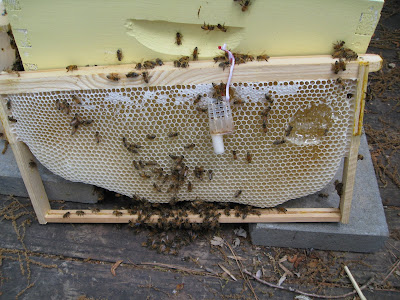Yesterday I went into my hives with the video camera, planning to make a video on how to do a hive inspection. The reason there's no video with this post is that I didn't get a good film. I opened four hives and in each instance, there was an auditory issue - in three of the four hives, an airplane flew overhead as I began the inspection! In the fourth hive, my dogs started barking loudly, making it difficult to hear.
The next problem is that I did the inspection at noon while the sun was overhead and thus the lighting was terrible. As a result you can't see anything on the frames that I pulled out. I also positioned the camera so that it focused on the hive. So when I pulled a frame and held it up to look at it, the frame was out of sight of the camera.
I may post one of these films to keep my promise to make one this weekend, but I definitely will be doing it again and differently.
The most upsetting thing I found in inspecting these hives was that one of my nuc hives appears to have no queen. These three nucs were installed last Friday, one week ago. Two of the hives have very active queens - I've seen Her Majesty in each of those hives and can see eggs and new brood in those hives.
In the nuc hive on my deck, there is absolutely no new brood after a week. I searched through the hive again today and still didn't see the queen on any frame and there were no eggs, brood or young larvae.I called the man from whom I purchased the nuc and he said he would get a queen for me and call me when she arrived so I could come and pick her up.
Meanwhile I have a queenless hive full of bees and eager to draw out comb, etc. They have polished the cells where new workers are hatching and are waiting, but there's no queen to lay eggs in them.While I am waiting for the new queen to arrive, I borrowed a frame of eggs, brood, etc. from Mellona to add to this hive.

If you double click on the frame above, you can see eggs in the 12:00 position in each cell. These are newly laid and will give the hive a chance to make its own queen. There is some capped worker brood in this frame on the side you can see as well as lots of pollen both in picture one (side A) and in the picture below (side B)

You can see how many bees are in Mellona in the picture below. You can see where I took the frame of brood and eggs. In its place I put a starter strip frame on the side of the box and pushed the frames closer together to make up for the space from my removal of the frame.
When I took the frame out, I shook it hard to send any bees remaining on it back into their home hive, Mellona. The remaining bees clinging to the frame I was moving were nurse bees. I checked each bee carefully to make sure I wasn't moving the queen out of her hive and then placed the frame into the nuc hive.











































